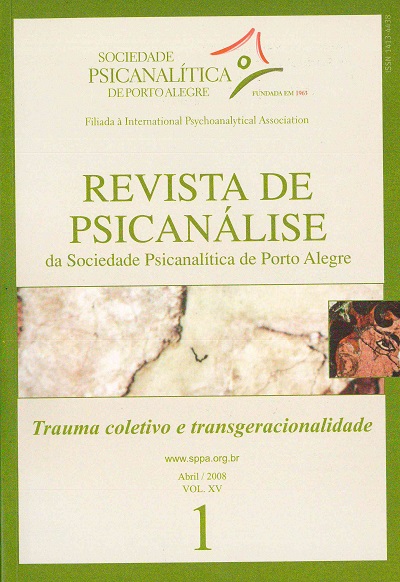A história de um grupo: uma visão analítica do uso da contação de histórias para romper a transmissão do silêncio
DOI:
https://doi.org/10.5281/sppa%20revista.v15i1.484Palavras-chave:
Transmissão de trauma, Contação de histórias, Perpetradores, Sobreviventes, Estereótipos, IdentidadeResumo
Descreve-se um grupo bem-sucedido de crianças composto de filhos de perpetradores nazistas e filhos de sobreviventes do Holocausto. A contação e escuta de histórias de outros são decisivas para a elaboração do próprio legado e as internalizações. O grupo usou este modelo com outros grupos em conflito ativo. O processo deste grupo é considerado a partir de um ponto de vista analítico (AU)
Downloads
Referências
BAROCAS, H. A.; BAROCAS, C. B. (1979). Wounds of the fathers: the next generation of holocaust survivors. International Review of Psycho-Analysis. v. 3, p. 331-340.
BAR-ON, Dan (1989). Legacy of Silence. Cambridge: Harvard U. Press.
_____. (1993). First Encounter between children of survivors and children of perpetrators in the holocaust. Journal of Humanistic Psychology. v. 33, n. 4, p. 6-14.
_____. (2006). Tell your life story: creating dialogue among jews and germans, israelis and Palestinians. Budapest: C.E. Press.
_____. et al. (Ed.) (2000). Bridging the gap. Hamburg: Koerber.
BERGMAN, M.; JUCOVY, M. E. (Ed.) (1982). Generations of the holocaust. New York: Basic Books.
BION, W.R. (1961). Experiences in groups and other papers. London: Tavistock.
BRUNER, J. (1990). Acts of Meaning. Cambridge: Harvard University. Press.
CLAY, Catrine. Children of the third reich. London: BBC production; Time Watch, 1993. 1 DVD (50 min)
DANIELI, Yael (1984). Psychotherapists’ participation in the conspiracy of silence about the holocaust. Psychoanalytic Psychology. v. 1, n. 1, p. 23-42.
EPSTEIN, Helen (1979). Children of the holocaust. New York: Penguin Books.
GRINBERG, Leon (1993). New introduction to work of Bion. New Jersey: Jason Aronson.
GUBRICH-SIMITIS, Ilse G. (1981). Extreme traumatization as cumulative trauma. Psychoanaltyic Study of the Child. v. 36, p.415-50.
HARDTMANN, Gertrud. (1982). Shadows of the past. In: BERGMANN, M. S.; JUCOVY, M.E. (Ed.) Generations of The Holocaust. New York: Columbia U. Press.
KESTENBERG, Judith, (Ed.) (1982). The persecutor’s children. In: BERGMANN, M. S.; JUCOVY, M. E. (Ed.) Generations of the Holocaust. New York: Columbia U. Press.
LAUB, D.; AUERHAHAN, N. (1985). Knowing and not knowing the Holocaust. Psychoanalytic Inquiry. v.5, n.1.
MONTVILLE, Joseph V. (1990). The psychological roots of ethnic and sectarian terrorism. In: VOLKAN, Vamik D.; JULIUS, D. A.; MONTVILLE, Joseph V. (Ed.). The psychodynamics of international relationships. Lexington: Lexington Books, 1991. p. 163-180.
NIEDERLAND, W.G (1981). The survivor syndrome: further observations and dimensions. J. Amer. Psychoanal. Assn. v. 29, p. 413-425.
SHAPIRO, R. L. (1991). Psychoanalytic theory of groups and organizations. J. Amer. Psychoanal. Assn. v. 39, p. 759-781.
SICHROVSKY, Peter (1988). Born guilty: children of nazi families. New York: Basic Books.
VARDI, Dina. (1982). Memorial candles: children of the Holocaust. Tavistock: Routledge.
VOLKAN, Vamik (2004). Blind trust: large groups and their leaders in times of crises and terror. Charlottesville: Pitchstone.
WIEDERHORN, Jessica. (2005). Testifying in the grey zone: testimonies from the Shoah Foundation Oral History Collection. Presented at Oral History Association, Providence: R.I. Unpublished paper.
WIESEL, Elie (1999). The perils of indifference. Speech given at the White House on Apr. 12.
Downloads
Publicado
Como Citar
Edição
Seção
Licença
Atribuo os direitos autorais que pertencem a mim, sobre o presente trabalho, à SPPA, que poderá utilizá-lo e publicá-lo pelos meios que julgar apropriados, inclusive na Internet ou em qualquer outro processamento de computador.
I attribute the copyrights that belong to me, on this work, to SPPA, which may use and publish it by the means it deems appropriate, including on the Internet or in any other computer processing.
Atribuyo los derechos de autor que me pertenecen, sobre este trabajo, a SPPA, que podrá utilizarlo y publicarlo por los medios que considere oportunos, incluso en Internet o en cualquier otro tratamiento informático.










